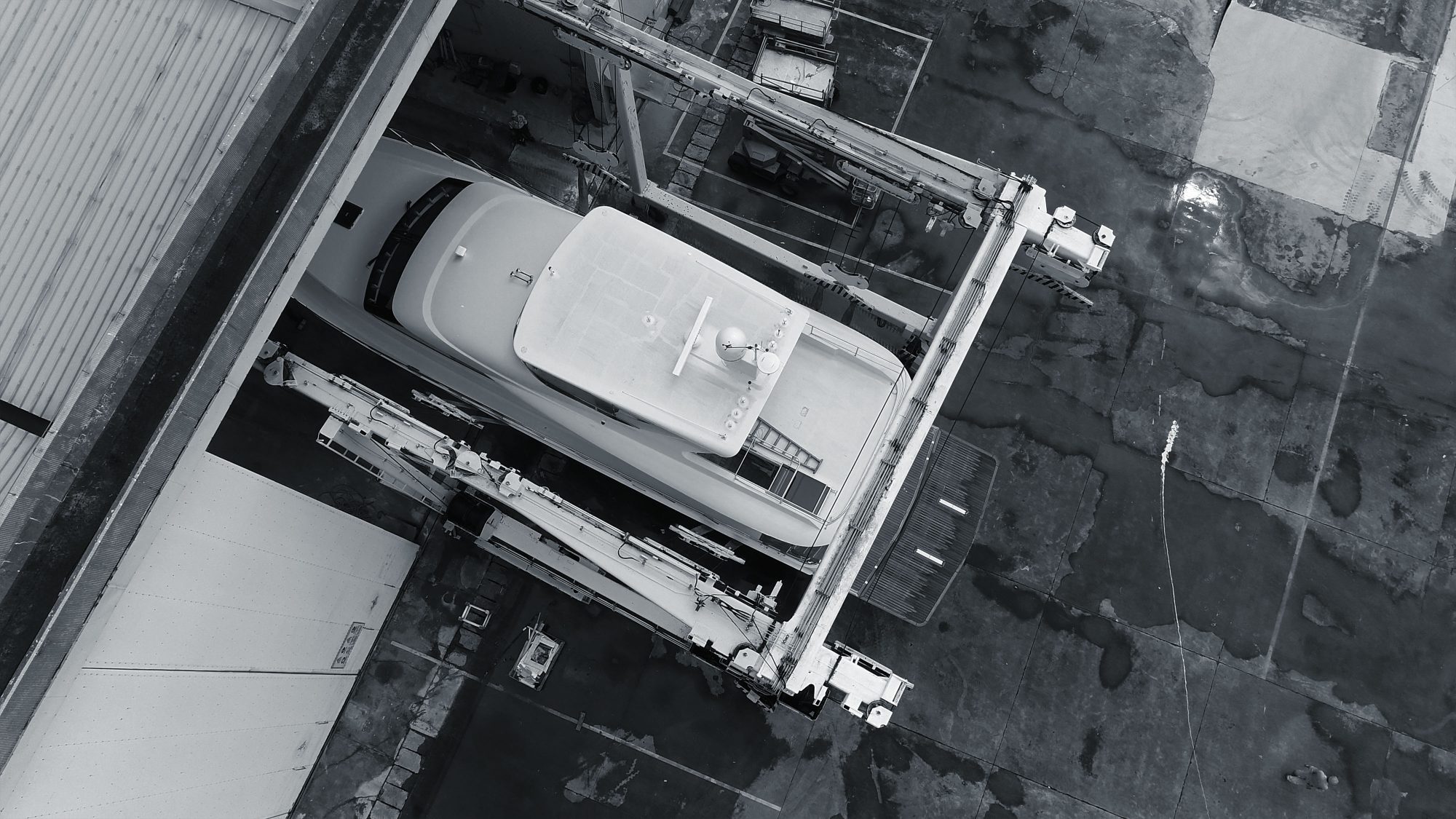As a fifth-generation member of the founding family of Cheoy Lee Shipyard, joining the yachting industry was a natural step for Hans Lo, project manager at Cheoy Lee.
He is passionate about working at this historic yard, which has played a pioneering role in the yacht construction sector and has a strong heritage.
Cheoy Lee’s story began with Lo’s great-great-grandfather joining the crew of a British merchant ship in his teens, before returning home to China and founding a refit yard. That was in 1870 and now, nearly 150 years later, his descendants – including Lo – still share his same passion for the sea and for yachting. “My great-great-grandfather got a lot of foreign business because he learned how to speak English during his time on the British ship – that was a pretty rare thing for a Chinese man in the 1800s,” says Lo. “That’s how our family first got into ships, and the yard kept doing repairs, manufacturing and retrofitting, but after the Sino-Japanese war the Japanese seized all of our property and our family fled to Hong Kong to escape Japanese occupation.”
Having re-established themselves in Hong Kong, in the 1930s the family founded Cheoy Lee shipyards in Hong Kong. Despite ups and downs, including land seizures during the war years, the family managed to keep hold of the yard site and a series of fortunate breaks, including a significant contract for 10 fishing boats for Korea, helped to secure Cheoy Lee’s future. The first step into building pleasure yachts came with a commission from three Americans to build a Sparkman Stephens sailing yacht called Mah Jong in 1957. That yacht is still on the water today, reflecting the quality of even those earliest builds. “She was one of the very first sailing yachts that we ever built and then, from there, we started looking seriously into pleasure craft,” says Lo. “At that point, in the 1950s and 1960s, teak sailing yachts were really popular in the United States… we had easy access to teak and we built a lot of these teak wooden sailing yachts and shipped them over to the US, and that’s where we started to build a name for ourselves, building quality sailing yachts.”
Ironically, it was building wooden boats that led to the yard deciding to build fibreglass yachts for the first time. “From the money that we got from building those teak sailing yachts, my grandfather decided to look into a new material to build yachts out of, and that material was fibreglass.” Back then, fibreglass was a little-used material in yacht building. The yard was helping to forge a new path. “We were one of the first people to ever use fibreglass and we used it for sailing yachts and eventually we looked into fibreglass for motor yachts,” explains Lo. In the 1970s the yard worked with Lloyds Register to develop layouts that are still in use today. “We then looked into a lot of new technologies that were related to fibreglass, such as using foam core construction, as opposed to just sandwich skins, in order to lighten the boats,” says Lo. “From there we also hired experts in fibreglass from the United States to come and teach us even more so, in many respects, we were absolutely pioneers for fibreglass building and that’s something that we’re very proud of.”
ver the years, the yard’s skill set continued to grow. “We’ve ventured into building all sizes of boats, using fibreglass of course, up to 39.6-metre Shango II.” At the time of her launch in 1977 Shango II was the largest fibreglass yacht ever built and represented a significant milestone for both the yard and the luxury yachting industry. The yard did not limit itself to fibreglass and built, and still builds, yachts from numerous materials including steel and aluminium. “Not many yards are capable of building in all three materials like that,” says Lo.
Today, Cheoy Lee produces 80% commercial projects and 20% pleasure craft. In late 2018 a rebrand to CL Yachts for their luxury production yachts arm was instigated, although larger custom builds still sit under the Cheoy Lee brand. At the same time, the Cheoy Lee brand also enjoyed a refresh, with an updated logo and new marketing. “Cheoy Lee, in the past, was known for custom yachts, so for custom builds we prefer to keep them under the Cheoy Lee name,” explains Lo. “For CL Yachts, our purpose is to build do spec boats as they allow us to produce in greater numbers and that’s what we want to move towards.” Eventually, the yard would like to achieve more even balance between work, with 60% commercial and 40% pleasure the goal.
Having these two distinct arms has ensured yard security during the ups and downs in the superyacht sector. “A lot of yards, in order to stay competitive, have to target whichever market is strong and shift sales in that direction, but for us, because we have the commercial side and the pleasure craft side, we are actually unaffected by these trends,” says Lo. “When the luxury side isn’t doing well, then the commercial side picks up that slack and that actually allows us a different kind of strength.”
As well as its position of strength being appealing to potential customers, Lo places a lot of stock on the yard’s innovative approach and long-proven boatbuilding skills, which are at the core of all the yard does today. “All the [yard’s] expertise is within the company itself, and the core members of Cheoy Lee – the Lo family – which is us, are shipbuilders first,” he says. “We’re not marketing people, we’re not sales people, we’re shipbuilders. I think that’s pretty rarified and interesting.” It is very important to Lo and the yard team to stress this commitment to skilled yacht building. “A lot of yards have control of the sales and marketing aspect, but the actual building of the product is just who is the cheapest builder, but that’s not us. We pride ourselves for being a product-driven company, and that’s really reflected in our brand: innovation and quality and product first.”
This commitment to quality has resulted in a loyal client base, who appreciate the yard’s heritage and pedigree construction. “People do recognise the quality, but it’s a double-edged sword for us too, as Cheoy Lee has been associated with a really classic look for motor yachts, so I think we’re also typecast in a way, especially in the American market,” says Lo. The yard is now trying to communicate that it is able to build a wide style of yachts and cater to the next generation of buyers. The brand positioning of the CL Yachts division has, in part, been an exercise in modernization. “We want to reintroduce ourselves as innovators and provide not just quality but also a modern look.”
Feedback on the rebrand of the CL Yachts arm has been widely positive, and the CLB72 model has proved the most popular to date, with five hulls sold since the design was introduced to the USA in 2018. The yard plans to keep expanding its range, with new models including the CLB88 and CLX96. “The CLB88 is very much a classic yacht reimagined,” says Lo. Other plans include a crossover style boat that the yard refers to as the ‘Sea Activity Vessel’ or SAV. “That is coming up, and we will likely build that on spec as we do not have an owner for it yet.” The long term plan for CL Yachts is to build smaller models, with the 96 the largest boat being built under the brand.
When developing the CL Yachts brand and range, the yard turned away from traditional yacht designers, seeking fresh eyes, and commissioned Milan-based designer Jozeph Forakis to undertake the development work. “We purposefully chose somebody that has no experience with the yachting industry because when you look around, you see a lot of cookie-cutter boats and a lot of the same ideas over and over,” says Lo. “What we wanted was someone that was fresh who can look at it with an outsider’s perspective.” This, paired with the experience of naval architect Michael Burvenich, led to the development of the new CL Yachts line.
In all that they do, the yard is placing an important focus on developing more environmentally friendly designs. “I think it’s getting more and more feasible for a yacht to be environmentally friendly, whereas many of the things that builders were previously doing around this were quite gimmicky,” says Lo. “I think the very notion of yachting goes against being green in the first place but we have to try for the sake of the environment.” Here Cheoy Lee’s commercial arm has again been an asset, as a means of trialling environmentally friendly technologies that could apply to the pleasure sector. This has included the investigation into hydro propulsion and testing it from a commercial standpoint. “Hopefully in the future we’ll be able to implement some of these technologies into pleasure craft.”
Looking to the future, Lo is feeling confident. “I think the market and economy is strong right now and we’re finally back in that period where we’re able to sell some boats.” Throughout it all, staying true to the family roots and values will be key and interacting with the yard’s loyal customer base is one of the most rewarding parts of the job for Lo. “I think I’m more sentimental about the people that buy the yachts than I am about the yachts themselves and I really like seeing owners come back to tell us about how they enjoy their boats,” he says. “Just yesterday we had a family meet with us and my grandfather had sold this man’s father his boat. That’s special.” It seems certain that there are still many generations of owners who will be enjoying the fruit of the Lo family’s labours in years to come. Cheoy Lee is in good hands.












